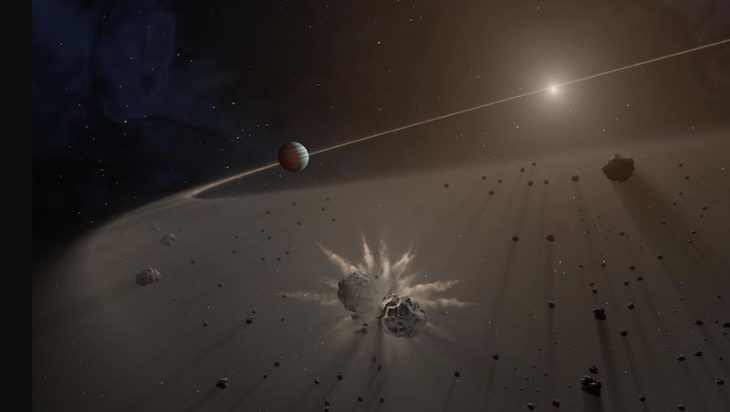When humans began space exploration, the first question that appeared was how did our planet form? With the discovery of many other planets, it changed to how the solar system was formed? A long-standing theory remains that the system was shaped by mega-collisions between rocky bodies.
Astronomers have now spotted a giant debris cloud made from the collision of two celestial objects in deep space that could provide insights into planetary formation. Several rocky planets, including Earth and the Moon, were formed or shaped by massive collisions early in the solar system’s history, as with every collision they kept accumulating material, increasing in size or breaking apart into smaller pieces.
In a study published in the Astrophysical Journal, astronomers said, “The system’s evolutionary state (right after the dispersal of its gas-rich disk) makes it extremely valuable to learn about the process of terrestrial-planet formation and planetary architecture through future observations.”
SPITZER’S EYE SPOTS MEGA COLLISION
Led by Kate Su of the University of Arizona, astronomers used the now-retired Spitzer Space Telescope to report the first observations of a debris cloud from one of these collisions as it passed in front of its star and briefly blocked the light. This method of finding objects in deep space is known as the transit method.
The observations enabled the researchers to directly determine the size of the cloud shortly after impact, estimate the size of the objects that collided, and watch the speed with which the cloud dispersed. “There is no substitute for being an eyewitness to an event. All the cases reported previously by Spitzer have been unresolved, with only theoretical hypotheses about what the actual event and debris cloud might have looked like,” said George Rieke, coauthor of the new study.
The astronomers were observing HD 166191 and conducted over 100 observations around it between 2015 and 2019. Astronomers observed that around the 10-million-year-old stardust leftover from its formation has clumped together to form rocky bodies called planetesimals. Once the gas that previously filled the space between those objects has dispersed, catastrophic collisions between them become common.
FORMATION OF PLANETS
Nasa said that while the planetesimals are too small and distant to resolve by telescope, their smashups produce large amounts of dust. Spitzer detected infrared light or wavelengths slightly longer than what human eyes can see. The initial clash generated enough energy and heat to vaporize some of the material. It also set off a chain reaction of impacts between fragments from the first collision and other small bodies in the system.
The research suggests the cloud was highly elongated, with a minimum estimated area three times that of the star. To produce a cloud that big, the objects in the main collision must have been the size of dwarf planets, like Vesta in our solar system an object 330 miles (530 kilometers) wide located in the main asteroid belt between Mars and Jupiter,” Nasa said in a statement.
“By looking at dusty debris disks around young stars, we can essentially look back in time and see the processes that may have shaped our own solar system. Learning about the outcome of collisions in these systems, we may also get a better idea of how frequently rocky planets form around other stars,” said Kate Su.
Astronomers have long been looking to spot planets that are evolving and the new discovery could pave way for the first such observations.






